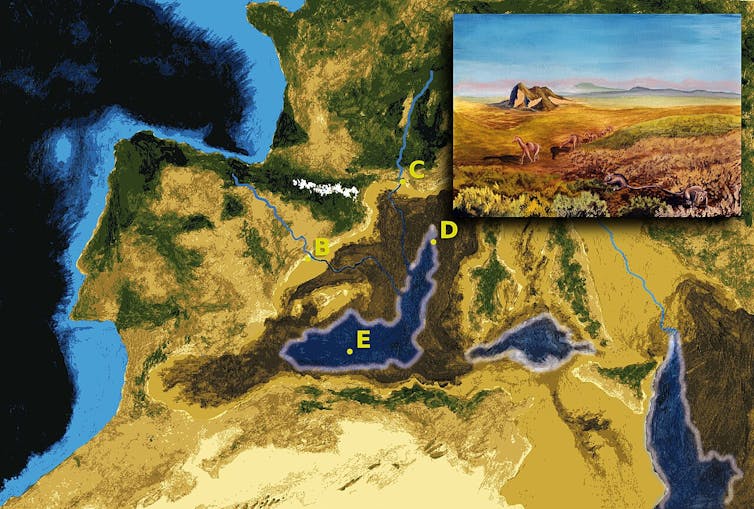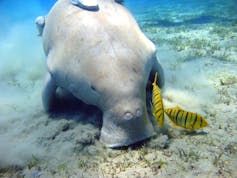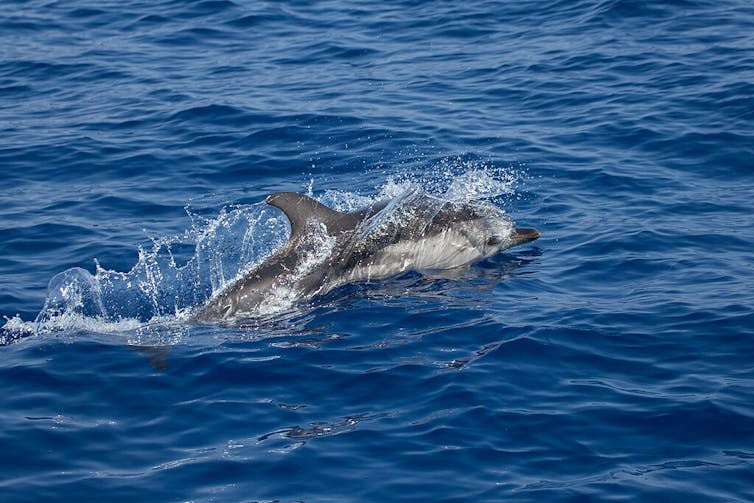What would happen if humans dried out the Mediterranean sea, turning it into a giant salt lake? Would its wildlife survive, and if so, how long would it take to recover?
Wikimedia Commons, Devilm25 (map), VulcanTrekkie45 (translation), CC BY
These may seem like wildly theoretical questions, but not for Herman Sörgel, a Bavarian architect who dedicated much of his life to this exact project: building a giant dam across the Strait of Gibraltar, letting the Mediterranean dry up, and colonising the land reclaimed from the sea.
Sörgel organised lectures and documentaries and raised funds until the 1950s for a project which, he believed, would promote cooperation between Africa and Europe, and power both continents through gigantic hydroelectric megaprojects.
What he did not know was that his dream had already come true at the end of the Miocene era, 5.5 million years ago, as a simple result of natural forces.
When the Mediterranean disappeared
Since the 1970s, several generations of marine geologists and geophysicists have confirmed the existence of a one to three kilometre thick layer of salt buried throughout most of the deeper parts of the Mediterranean Sea.
This is almost a million cubic kilometres of salt that testify to a brief period when the Mediterranean was isolated from the rest of the world’s oceans – brief in the geological sense, as the episode lasted about 190,000 years.
The culprit was not, of course, an eccentric German architect, but plate tectonics. The Mediterranean basin, trapped between two continents that today continue to move closer by up to two centimetres every year, was cut off from the Atlantic. Its waters quickly evaporated due to the region’s arid climate, leaving behind vast amounts of salt.
This episode, known as the Messinian salinity crisis (the Messinian being the last period of the Miocene), is the biggest extinction event suffered by the Earth since the meteorite that wiped out the flightless dinosaurs and ended the Mesozoic era 65 million years ago.

Pau Bahí y Daniel García Castellanos/Wikimedia Commons, CC BY-SA
As a result, no geoengineering experiments are needed to answer our initial question: how resilient is marine life in the face of an environmental crisis of this magnitude?
The answer has just been published in the journal Science, in a study led by Konstantina Agiadi of the University of Vienna in collaboration with the Spanish National Research Council and 28 other scientists from 25 European institutes.
After gathering all Mediterranean fossil data from between 12 and 3.6 million years ago, the results suggest that native marine life was virtually extinct when the Mediterranean was cut off, and that subsequent recolonisation by Atlantic species gave rise to a Mediterranean fauna more similar to the one we find there today.
Native, extinct and migrant species
By statistically analysing information from more than 750 scientific papers, we were able to document 22,932 presences of a total of 4,897 marine species living in the Mediterranean. Before the crisis, 779 species could be considered endemic species (i.e. documented only in the Mediterranean). Of those, only 86 were still present after the salinity crisis. All the tropical corals that were abundant in the Mediterranean before this cataclysmic environmental change disappeared.

Julien Willem, Wikimedia Commons, CC BY-SA
However, some apparently endemic sardine species managed to survive. The sirenian, a sea mammal related to today’s manatees and dugongs (also known as sea cows) also survived.
Because fossil records are limited and fragmented we cannot be certain that these species were all endemic, or that they would not have survived outside the Mediterranean, hence the value of basing our study on statistics from a large number of species. But for those that were endemic, where did they manage to survive, and what refuges did they find to avoid the radical increase in salt levels and temperature?
These questions remain unanswered, but we have been able to establish that changes in populations are the result of replacement by Atlantic species after the Mediterranean’s re-flooding, rather than rapid adaptation to the new hypersaline environment. In other words, life did not have enough time to adapt, and the extinct species were replaced by Atlantic species that migrated into the Mediterranean.
Several iconic species, such as the great white shark and the dolphin, only appeared in the Mediterranean after the crisis. Even more interestingly, the current richness of fauna in the western Mediterranean only came after the re-flooding – previously, the eastern Mediterranean (Ionian and Levantine Seas) had possessed a higher number of different species.

Francesca Grossi/Wikimedia Commons, CC BY
Lessons on mass extinction
The impact of the Mediterranean’s isolation on its fauna and flora was catastrophic, destroying most of its ecosystems. Another significant finding from our research is that it took more than 1.7 million years for species numbers to recover. This slow recovery of the richness of Mediterranean ecosystems provides the first detailed quantification of how wildlife responds to an extinction event of this magnitude.
The Mediterranean’s biodiversity today is very high thanks to the presence of numerous endemic species. Our results suggest that this was also the case six million years ago, but that the vast majority of these endemic species disappeared when it was cut off from the Atlantic.
Perhaps another lesson learned from this study is that, however tempting it may be to believe that geoengineering projects can allow us to maintain our current rate of emissions and ecosystem destruction, the Earth’s geological past will reveal more than any experiment.
When the Mediterranean was reconnected to the Atlantic, it was repopulated by the huge reserve of species in the world’s oceans, yet it still took millions of years for the Mediterranean’s ecosystems to recover in terms of richness. No one knows yet how long it will take for marine life to recover from the kind of global-scale change that is currently underway.

The post “5.5 million years ago the Mediterranean dried out, with sobering lessons for humanity today – new research” by Daniel García-Castellanos, Earth scientist, Instituto de Geociencias de Barcelona (Geo3Bcn – CSIC) was published on 08/29/2024 by theconversation.com

































Leave a Reply